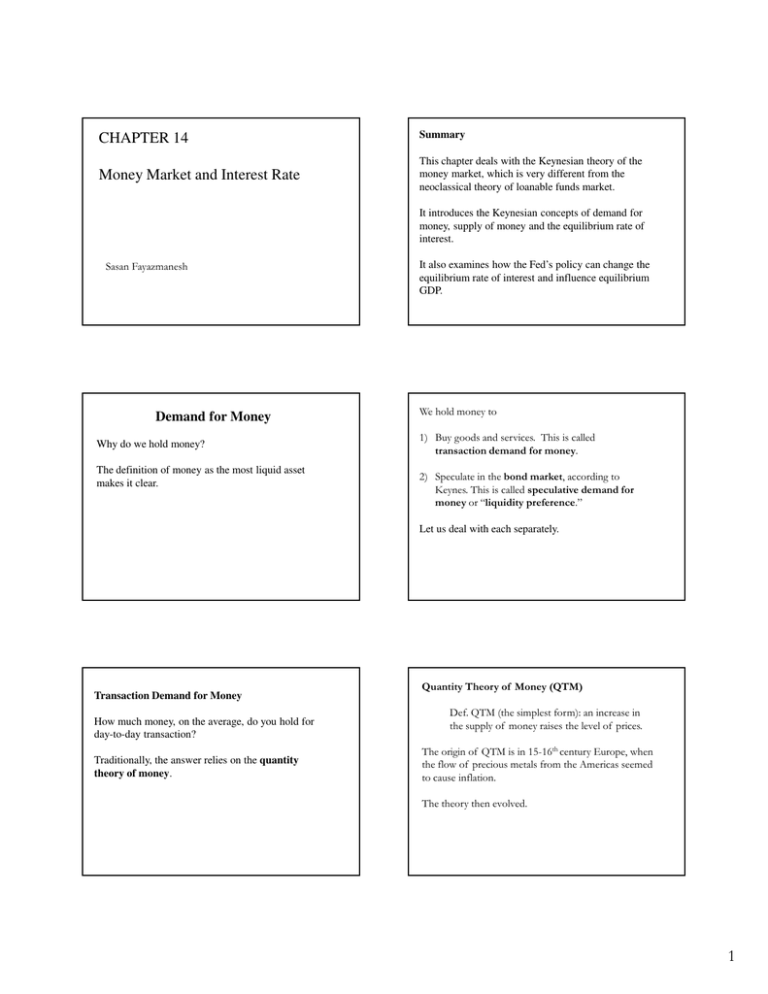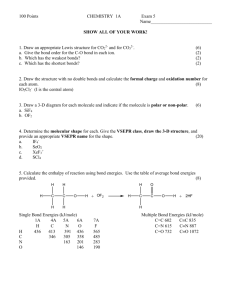CHAPTER 14 Money Market and Interest Rate
advertisement

CHAPTER 14 Summary Money Market and Interest Rate This chapter deals with the Keynesian theory of the money market, which is very different from the neoclassical theory of loanable funds market. It introduces the Keynesian concepts of demand for money, supply of money and the equilibrium rate of interest. Sasan Fayazmanesh Demand for Money Why do we hold money? The definition of money as the most liquid asset makes it clear. It also examines how the Fed’s policy can change the equilibrium rate of interest and influence equilibrium GDP. We hold money to 1) Buy goods and services. This is called transaction demand for money. 2) Speculate in the bond market, according to Keynes. This is called speculative demand for money or “liquidity preference.” Let us deal with each separately. Transaction Demand for Money How much money, on the average, do you hold for day-to-day transaction? Traditionally, the answer relies on the quantity theory of money. Quantity Theory of Money (QTM) Def. QTM (the simplest form): an increase in the supply of money raises the level of prices. The origin of QTM is in 15-16th century Europe, when the flow of precious metals from the Americas seemed to cause inflation. The theory then evolved. 1 In 1911 Irving Fisher (American economist) expressed QTM as: Example of MVT = PT Suppose we have 3 transactions, each worth 1 dollar: MVT = PT $1 Where: A M is the supply of money T is the number of transactions P is the level of prices VT is the transaction velocity of money $1 MVT = PT B $1 C T=3 M = $1 P = ($1 +$1 +$1) / 3 = $1 VT = [$1 (1) +$1 (1) +$1 (1)] / $1 = 3 Another example Again, we have 3 transactions: $1 (3) = $1 (3) $2 This is a tautology, it states that spending is equal to spending. A B $1 $1 C T=3 M = $2 P = ($2 + $1 + $1) / 3 = $4/3 VT = [$2 (1) + $1 (1) + $1 (1)] / $2= $4/$2 = 2 Again, MVT =PT: $2 (2) = ($4/3) 3 In 1917, the economists in Cambridge University (England) expressed QTM (called “Cambridge Cash Balance Approach”) as: MVy = Py Where: M is the supply of money (Ms) y is real income P is the level of prices Vy is the income velocity of money Q: If y is real income then Py must be what? A: nominal income. Q: Which V is larger, VT or Vy and why? A: VT > Vy 2 The Cambridge approach led to the concept of transaction demand for money: It was usually assumed in the early models of QTM that Vy is constant. We can rewrite MVy = Py as If this the case, then 1/Vy is constant as well. M= Py/Vy Suppose money supply M (or Ms) is equal to money demand Md: So Md = Py/Vy = k (Py) Where k = 1/Vy is a constant. Md = Ms = Py/Vy The Transaction Demand for Money (MdT ) MdT = k (Py) This states that people keep a fixed portion of their nominal income for transaction. For example, if k = 1/20 (that is Vy = 20), and people receive $1000 in income, they keep, on the average, $50 to do shopping . Speculative Demand for Money (MdS) or “liquidity preference” Keynes assumed that people hold money for other reasons, particularly speculation in the bond market. Note: MdT = k (Py) means that transaction demand for money depends on two factors, P and y: MdT = f (P, y) When P , MdT y , MdT and But you can sell a bond at a higher or lower price than its face value, depending on the demand for bonds. So people have a choice between holding bonds or holding cash. Def. Bond is an IOU issued by a corporation or government. It has a face value, and when it matures it pays you the face value plus interest. 3 We assume, after Keynes, that there is an inverse relation between interest rates and how much cash people hold for speculation in the bond market. That is, people hold less cash at higher interest rates and more cash at lower interest rates: Speculative demand for money or “liquidity preference” Interest rate (i) i1 MdS = f (i) When i i2 MdS MdS M1 Total Demand for Money M2 Cash holding (M) Total demand for money The total demand for money consists of transaction and speculative demands for money: Interest rate (i) Md = MdT + MdS This means that: Md = f (i, P, y) MdT MdS Cash holding (M) Total demand for money Total demand for money Interest rate (i) Interest rate (i) MdT Md T Md S Md Cash holding (M) Md = f (i, P, y) Cash holding (M) 4 Shifts or Changes in Demand for Money Demand for money: Inflation increases Interest rate (i) Md = f (i, P, y) Q: What happens to demand for money if • Inflation rises? • Real income increases? Md1= f (i0, P1, y0) Md0= f (i0, P0, y0) M Demand for money: Real income increases Supply of Money Interest rate (i) In the Keynesian model, it is assumed that the central bank can target the money supply independently of the interest rate. This means the supply of money, Ms, is vertical. Md1= f (i0, P0, y1) Md0= f (i0, P0, y0) M Shifts or Changes in Supply of Money The supply of money Interest rate (i) Fed can use monetary policy to increase or decrease the money supply. Ms Suppose Fed wants to increase the supply of money. What should it do? 1) Buy government securities 2) Reduce the required reserve ratio 3) Reduce the discount rate M 5 Equilibrium in the Money Market Supply of money increases i Ms0 In the Keynesian model, the equilibrium rate of interest, ie, is reached when the supply of money is willingly held by people. Ms1 M Disequilibrium in the Money Market Equilibrium rate of interest i Suppose the rate of interest is higher than the equilibrium rate. Ms What is happening in the money market? ie Md M Md=Ms Interest rate above the equilibrium Interest rate above the equilibrium i i Ms i1 i1 Excess supply of money Md Ms Md M M Md1 < Ms1 6 The Inverse Relation between Bond Prices and Interest Rates on Bond Excess supply of money The inverse relation between bond prices and interest rates can be shown mathematically. Excess demand for bonds Bond prices But it can also be shown using a “discount bond,” such as a Treasury bill (T. bill). Interest rate on bonds Why would the interest rate fall? Def. A discount bond pays no interest, but can be purchased at a discount, below its face value. When it matures, you get the face value. The difference between what is paid for and the face value is the interest. Example, A bond has a face value of $100. You buy it at $80. Interest rate = ($100 − $80)/ $80 = $20/$80 = 25% Suppose the price of the bond rises to $90. Joe buys it at $90. Interest rate = ($100 -$90)/ $90 = $10/$90 = 11.1% Bond price rose and interest rate fell! Interest rate above the equilibrium Interest rate below equilibrium i i Ms Ms i1 i0 Md Excess demand for money i2 M Md M Ms2 < Md2 7 Interest rate below equilibrium i Excess demand for money Ms Excess supply of bonds Bond prices Interest rate on bonds i0 Md i2 M The Effect of Fed’s Monetary Policy on the Rate of Interest Easy money policy: Increase MS i Ms0 Fed can change the short term interest rate by increasing or decreasing the money supply. i0 Excess supply of money Ms1 Def. Easy money policy: increasing the money supply. Def. Tight money policy: decreasing the money supply. i1 Md M Ms0 Tight money policy: Decrease MS Monetary Policy, Changes in the Interest Rate and Equilibrium Output i Ms1 Ms1 Ms0 How can the action of the Fed influence output and income? i1 Excess demand for money i0 Md M Ms1 Ms0 8 Investment and Interest Rate Investment: interest rate falls Keynesian economics assumes that there is an inverse relation between interest rate and investment. Interest rate (i) This is similar to the neoclassical assumption, but the reasoning is very different. i1 i2 Planned Investment (Ip) Investment (I) I1 Planned investment: Interest rate falls I2 Consumption and Interest Rate Investment (I) Consumption, too, depends on the interest rate: C = f (y, W, i, E) I1 What would happen to the consumption function when the interest rate falls? I0 y Consumption: Interest rates fall Equilibrium Output and Interest Rate C C1 = f (y0, W0, i1, E0 ) a1 Changes in the interest rates therefore influence interest rate sensitive expenditures I and C. C0 = f (y0, W0, i0, E0 ) a0 y 9 Monetary Policy and Changes In Equilibrium Output Aggregate expenditure: interest rate falls AE = Y AE (C, I) If the Fed changes the money supply and interest rate, interest sensitive expenditures will change, changing the level output or income. AE1 = C1+ I1 AE0 = C0+ I0 450 y y0 y1 Example: Easy money policy: Easy money policy and aggregate expenditure Ms i i AE Ms0 Ms1 C, I AE1 y AE0 i0 i1 Md 450 M y0 y1 Fed buys government securities, lowers r or discount rate Tight money policy and aggregate expenditure Some complications in the argument! i Changes in the real national income (y) must have a feedback effect on the demand for money, since we assumed: AE Ms1 Ms0 AEo AE1 i1 i0 Md y1 y0 Fed sells government securities, raises r or discount rate Md = f (i, P, y) In other words, if the Fed engages in easy or tight money policy, it must change money demand. 450 M y y 10 Example: Easy money policy: Easy money policy: y increases Ms i i AE Ms1 C, I AE1 AE2 AE0 y Md i2 i Md1=f(y1) i1 C, I Md0=f(y0) y 450 M How far will y fall? Will it go back to its original level? Will it be in between the two levels? y0 y2 y1 y Keynesian view i AE Ms1 The answer depends on theoretical perspective: 1) Keynesians: y will ultimately fall somewhere in between y0 and y1. AE1 AE2 AE0 i2 Md1=f(y1) i1 Md0=f(y0) 450 M 2) Monetarists (modern neoclassicals who use Keynesian tools of economic analysis): Thus in the long-run there is “complete crowding out,” i.e., no increase in output. Monetary policy is ineffective in increasing output and employment in the long-run. y Monetarist view: Short run i y will expand in the short-run. But in the long-run y returns to its original position. y0 y2 y1 AE Ms0 Ms1 AE1 AE0 i0 i1 Md 450 M y0 y1 y 11 The same arguments are used in the case of fiscal policy Monetarist view: Long-run i 1) Keynesians: fiscal policy is effective in changing output and employment even if we assume money demand changes. AE Ms1 AE1 i2 Md1=f(y1) i1 2) Monetarists: fiscal policy is ineffective, particularly in the long-run. AE0≡ AEFinal Md0=f(y0) 450 M y0=yFinal y1 y Monetarists on fiscal policy: Short-run Monetarists on Fiscal Policy: Long-run AE i AE Ms1 AE1 AE1 i2 AE0 ∆G i1 450 y0 y1 y AE0≡ AEFinal Md1=f(y1) Md0=f(y0) M 450 y0=yFinal y1 y Next stop: Chapter 15! 12





